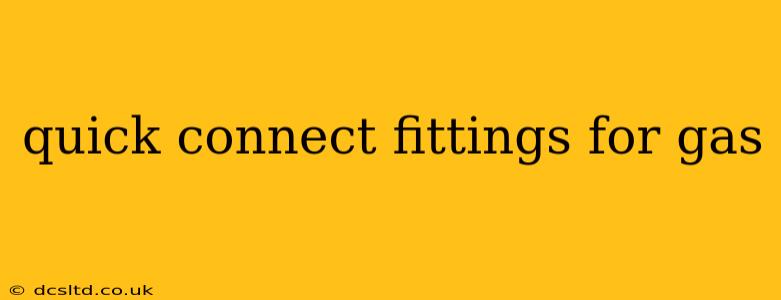Quick connect fittings are revolutionizing gas line installations, offering speed, efficiency, and safety improvements over traditional methods. These fittings, often used for propane and natural gas applications, utilize a simple, reliable mechanism for quick and secure connections, minimizing the need for complex tools and potentially dangerous threading. But understanding the nuances of these fittings is crucial for safe and effective usage. This guide will delve into the world of quick connect gas fittings, addressing common questions and concerns.
What are Quick Connect Fittings for Gas?
Quick connect fittings, also known as push-to-connect or self-sealing fittings, are designed for rapid and reliable gas line connections. They employ a simple mechanism where a gas appliance hose or pipe is inserted into the fitting, creating a secure seal. This eliminates the need for time-consuming and potentially error-prone threading techniques, reducing installation time and the risk of leaks. These fittings typically feature a locking mechanism to ensure a secure connection and prevent accidental disconnections. They come in various sizes and configurations to accommodate diverse gas appliance needs.
What are the Advantages of Using Quick Connect Fittings?
The benefits of using quick connect gas fittings are numerous:
- Speed and Efficiency: Installation time is significantly reduced compared to traditional threaded connections.
- Ease of Use: No special tools or expertise are required for installation, making it a DIY-friendly option.
- Improved Safety: The reduced handling of tools and the secure locking mechanism minimizes the risk of leaks and injuries.
- Reduced Maintenance: Fewer components and a simpler design translate to less maintenance and fewer potential points of failure.
- Cost-Effectiveness: While the initial cost of fittings might be slightly higher, the reduced labor costs and increased efficiency often outweigh this.
What are the Different Types of Quick Connect Fittings for Gas?
Quick connect fittings for gas lines aren't all created equal. Several types exist, each designed for specific applications and pressures:
- Propane Quick Connects: These are designed for use with propane gas, often found in grills, portable heaters, and RVs. They typically have a different configuration than natural gas quick connects to prevent accidental mismatching.
- Natural Gas Quick Connects: Used for natural gas appliances, these fittings are designed to handle the different pressure characteristics of natural gas. Again, these differ from propane connectors to ensure safety.
- Different Size and Pressure Ratings: Quick connect fittings are available in a range of sizes and pressure ratings to accommodate different appliances and gas flow requirements. Always select a fitting that matches the specific application's specifications.
Are Quick Connect Fittings Safe for Gas?
When properly installed and used, quick connect fittings are considered safe. However, several factors are crucial for maintaining safety:
- Proper Installation: Ensure the fitting is correctly installed and securely locked. Refer to the manufacturer's instructions for detailed installation procedures.
- Regular Inspection: Regularly check the connections for any signs of leaks or damage. A soapy water test can be used to detect leaks.
- Using Correct Fittings: Only use fittings that are specifically designed for gas applications and compatible with the gas type (propane or natural gas) and pressure rating.
- Manufacturer's Instructions: Always follow the manufacturer's instructions for installation, operation, and maintenance.
How do I Disconnect a Quick Connect Gas Fitting?
Disconnecting a quick connect fitting typically involves a simple release mechanism. This might involve pushing a button, lever, or collar. Consult the manufacturer's instructions for the specific disconnect procedure for your particular fitting type. Never attempt to forcefully disconnect a fitting, as this can damage the components and create a hazardous situation.
Can I Use Quick Connect Fittings on Existing Gas Lines?
The suitability of quick connect fittings on existing gas lines depends on the existing infrastructure and local codes. In some cases, it may be necessary to modify existing lines to accommodate quick connect fittings. It's essential to consult with a qualified gas professional before modifying existing gas lines.
What are the potential drawbacks of quick connect gas fittings?
While quick connect fittings offer many benefits, it's important to be aware of potential drawbacks:
- Higher initial cost: The upfront cost of quick connect fittings might be slightly higher than traditional threaded fittings.
- Potential for misuse: Improper installation or use can lead to leaks or other safety hazards.
- Limited compatibility: Quick connect fittings are not always compatible with all gas appliances and lines.
By understanding the advantages, disadvantages, and proper use of quick connect fittings, homeowners and professionals can leverage their efficiency and safety features for gas line installations. Remember, always consult with a qualified professional when working with gas lines, and always prioritize safety.
